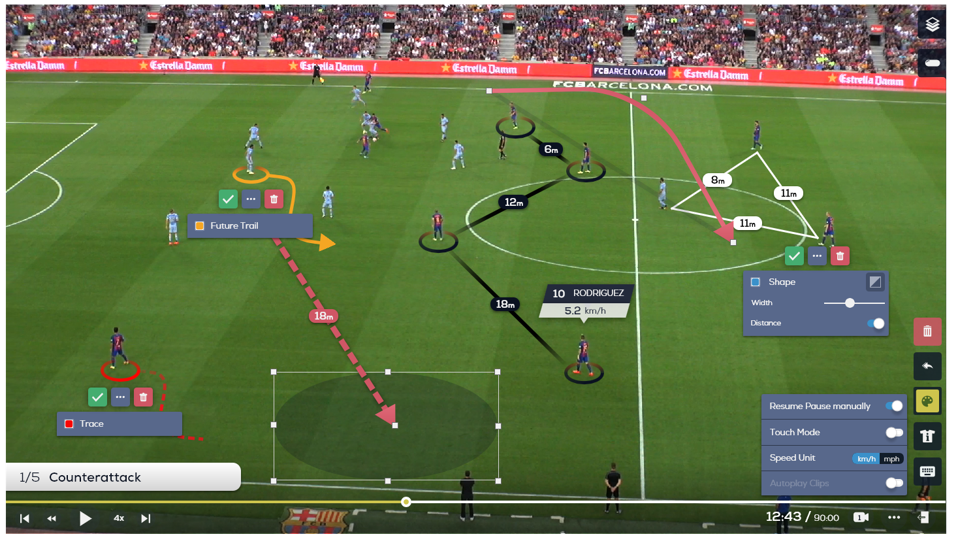Table of Contents
Today’s training landscapes in various sectors, including sports and aviation, are increasingly being shaped by cutting-edge gaming technologies. The integration of virtual reality, GPS tracking, and other advanced tools is revolutionizing traditional training methods, providing real-time data analysis and creating immersive simulation environments.
This comprehensive article explores the diverse applications of these technologies and their transformative effects on training programs, emphasizing how they enhance strategic planning, performance optimization, and interactive learning.
Performance Analysis: Understanding Video Analysis Software
The advent of video analysis software has significantly altered the landscape of performance analysis in sports. This technology enables a detailed examination of gameplay, allowing teams to dissect every move and strategy.
By analyzing video footage, coaches and athletes gain insights into performance dynamics, identifying critical strengths and areas for improvement. This rigorous data-driven approach allows for precise modifications in tactics and training, ensuring teams can enhance their play and secure a competitive edge in their respective sports.
Training and Conditioning: Virtual Reality and GPS Tracking
Virtual reality (VR) and GPS tracking represent a technological leap in sports training and conditioning. VR offers athletes immersive experiences that simulate real-world scenarios without the physical risks, while GPS devices provide continuous data on athlete’s movements and conditions.
This combination allows for a highly personalized training approach, enabling coaches to craft programs that address the specific needs of each athlete. Through these technologies, training sessions are not only about physical enhancement but also about strategic cognitive development, which is critical in high-stakes environments.
Injury Prevention and Rehabilitation: Advancements in Imaging and Wearable Technology
Technological innovations in imaging and wearable devices have dramatically improved the processes of injury prevention and rehabilitation. Modern imaging technologies like MRI and CT scans deliver clear and precise internal views, aiding in accurate injury diagnosis and effective treatment planning.
Simultaneously, wearable technologies monitor athletes’ physiological and biomechanical metrics in real time, identifying potential injury precursors before they result in actual harm. This proactive approach minimizes downtime and enhances the recovery process, ensuring athletes return to peak condition safely and swiftly.
Communication and Collaboration: Enhancing Team Interaction with Technology
The enhancement of communication and collaboration through modern technology has been a game-changer for sports teams. Real-time communication tools facilitate instant feedback and continuous dialogue among team members, regardless of their physical locations.
This seamless communication ensures that strategic decisions and adjustments are efficiently shared, fostering a collaborative environment where every member is aligned and informed. Enhanced connectivity not only optimizes operational effectiveness but also strengthens team dynamics, which are crucial for achieving collective goals.
The Strategic Application of Virtual Training in Ohio
The strategic application of virtual training tools in Ohio is not just advancing athletic abilities; it’s also reshaping how enthusiasts engage with sportsbooks. By incorporating promos to improve odds, sports fans can utilize insights from enhanced training regimens, aligning their wagering strategies with the sophisticated training technologies that shape modern athletes.
Enhancing Athlete Performance: Leveraging Real-Time Data for Optimal Results
Real-time performance data is now a cornerstone of athlete training regimes. This data allows coaches and trainers to make immediate and strategic adjustments to training programs, maximizing the efficacy of each session.
The ability to adapt to real-time insights helps athletes push their limits while ensuring that their training is aligned with their physical capabilities and goals. Such data-driven training methodologies foster an environment of continuous improvement, essential for maintaining competitive advantage in professional sports.
Optimizing Team Strategy: Data-Driven Decisions in Sports
The reliance on data-driven strategies has reshaped team management and performance optimization in sports. Teams equipped with analytical tools are better positioned to analyze their performances and predict future outcomes.
These insights enable coaches to craft strategies that are not only reactive to past performances but also proactive in anticipating opponent moves. As a result, teams can maintain a strategic upper hand, adapting quickly to the evolving dynamics of the game and securing victories.
Proactive Injury Management: Technology-Enabled Risk Assessment
Advancements in sensor technology and data analysis have ushered in a new era of proactive injury management in sports. By continuously monitoring athletes’ health and performance data, teams can predict potential injury risks and intervene before injuries occur.
This proactive management strategy is crucial for prolonging athletes’ careers and ensuring that they perform at their best. Effective risk assessment and management foster a safer training environment, which is fundamental for athlete longevity.
Streamlining Team Operations: The Role of Cloud-Based Solutions
Cloud-based solutions have revolutionized team operations by providing scalable and efficient tools for data storage, access, and analysis. These technologies enable teams to manage vast amounts of information seamlessly and access it instantaneously, regardless of location.
The impact of cloud computing extends beyond mere data management to include strategic planning and real-time decision-making, enhancing the overall efficiency and effectiveness of sports organizations.
Future of Sports Technology: Emerging Trends and Innovations
Looking ahead, the intersection of sports and technology holds promising innovations that will further revolutionize training and performance. Augmented reality (AR), biometrics, and machine learning are poised to deliver even more sophisticated training tools.
These technologies will provide deeper insights into athlete performance and health, crafting even more personalized training programs. As these technologies evolve, they will continue to redefine the own boundaries of what is possible in sports training, offering new opportunities for athletes to achieve their peak potential.
The future integration of Internet of Things (IoT) devices in sports is another exciting avenue. These devices will enable a network of connected sensors to gather data from athlete’s equipment, wearables, and the training environment, leading to ultra-precise analytics that can be used to further refine training conditions and methods.
This will not only improve the accuracy of performance assessments but will also enable a real-time feedback loop, enhancing the responsiveness of training adjustments.
Additionally, artificial intelligence (AI) will play a crucial role in processing the vast amounts of
data generated by these technologies. AI algorithms are expected to predict outcomes based on historical performance data, offering predictive insights that can be used to prevent injuries, optimize training loads, and improve performance.
Moreover, AI could personalize training and nutrition plans for each athlete based on their unique physiological and biomechanical data, potentially transforming the standard one-size-fits-all approach into a highly individualized training regimen.
Virtual fan engagement is another burgeoning field that stands to benefit from these technological advancements. As sports training technologies evolve, so too does the potential for fan interaction.
Fans might soon be able to train virtually alongside their favorite athletes, experience games from the athlete’s perspective, or even influence real-time decisions in games through interactive platforms. This fusion of technology and fan experience is poised to not only enhance the way fans interact with sports but also create novel revenue streams and marketing opportunities for teams and athletes.
In summary, the continual evolution of gaming technologies and their application in sports training are setting the stage for a future where technology and physical performance are more intertwined than ever. As these tools become more refined and accessible, they will undoubtedly unleash new levels of performance and revolutionize the training landscape across sports, propelling athletes to unprecedented heights of achievement and skill.









